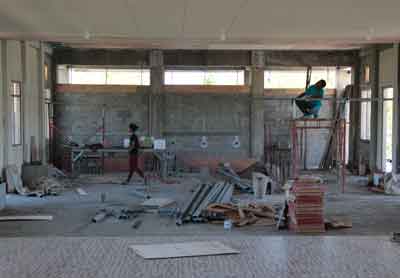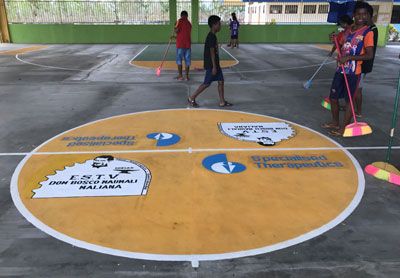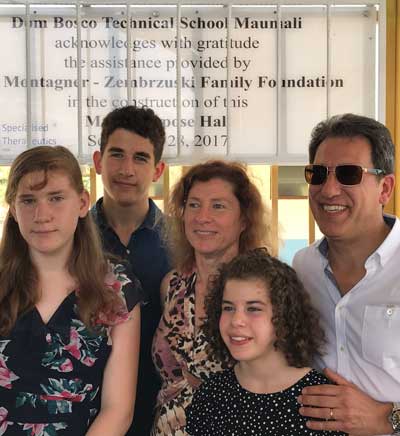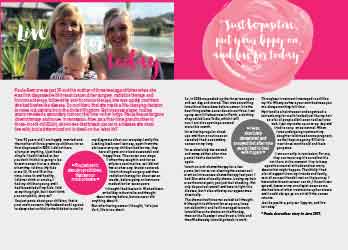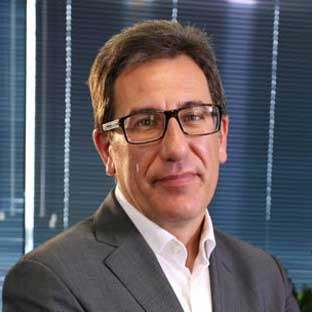
Carlo Montagner is the Chief Executive Officer and co-founder of Australia’s largest independent pharmaceutical company, Specialised Therapeutics Asia. The son of working-class Italian migrants, he and his wife Bozena established the company just over 10 years ago without any institutional investment and by selling accumulated personal assets, following international careers and diverse roles inside some of the world’s biggest and most successful pharmaceutical companies across Japan, Europe and in the United States. Buoyed by experience, Carlo and Bozena established Specialised Therapeutics with a single foundation product that was initially rejected, but went on to become one of the most successful chemotherapies ever commercialised in Australia. His company has since built an expansive drug portfolio, employs close to 50 staff with recently established regional headquarters in Singapore. These are his thoughts on becoming a pharmaceutical entrepreneur.
“ONE of our children aspires to eventually succeed me as the CEO of our independent pharmaceutical company. The other night she asked me, ‘So Dad, what school do I need to go to and learn how I run the company?’
A straightforward question, but one that got me thinking about whether entrepreneurs really are born or made, and how you school the next generation to innovate in pharma and to bring an entrepreneurial mindset to a high-risk, yet risk-averse environment.
Born or Made?
With the 20/20 vision afforded by hindsight, I can see that a large part of my own entrepreneurial mindset is ingrained. Yes, there have been many lessons along the way, there have been great mentors, there has been dogged determination, risk, planning, good decisions and what some may call luck or fate. There have been people and lessons along the way that helped achieve the next goal. But an inner drive to build a business and leave a legacy was part of my make-up. I doubt any of my primary school teachers would have predicted that I would one day create the largest privately owned pharmaceutical company in Australia. But I always had an inner desire to make an impact.
In my younger years, I toyed with the idea of pursuing a career in dramatic arts. However I soon realised that my acting ambition exceeded my talent. When a dramatic career appeared unlikely, I began working in a national retail chain of delicatessens to fund my university studies with the plan to become a clinical psychologist following graduation.
I quickly navigated the ranks to management and found myself at a crossroads: should I pursue retail management or stick to my psychology studies?
I loved the cut and thrust of the retail world. It allowed leadership with substantial people and fiscal responsibility, with scope to be creative and entrepreneurial. While the retail world is competitive and innovative, I decided this path long term would not provide the intellectual stimulation I enjoyed studying psychology.
It was during my post graduate studies in child psychology that I began to combine my passion for learning with my entrepreneurial vision.
I developed a plan to open a national network of specialist, education-based childcare centres. Obviously I was not the only one who saw that opportunity, but I was born into a hardworking migrant family who took on tremendous personal risk in emigrating to Australia but once established here were fiscally risk averse to investing in anything other than bank term deposits and the family home. I had developed a similar mindset. Without the initial capital (and willingness or even basic awareness to invest in high risk capital raising activities) I could not bring these plans to fruition.
Instead with my girlfriend of the time, and now-wife Bozena Zembrzuski, we bought land (a very safe traditional investment!), before heavily researching and undertaking feasibility studies into establishing an export-centred snail farm on Melbourne’s outskirts.
As a result of this research we had the confidence to invest our time and spare funds into what was, as the local newspaper reported at the time, quite a bizarre venture.
Somewhat ironically given my impending pharmaceutical career, we shelved these plans because of an extremely complicated bureaucratic landscape. There were simply too many local council and regulatory barriers in our path. While frustrated I could not build my own business at the time, I knew deep down that I wanted my own enterprise. It was about finding the right fit, at the right time.
It’s a Marathon, not a Sprint
Any successful entrepreneur needs to begin with the right idea and a crystal clear vision of the targeted outcome.
To back this up, you need heavy research, sound financials and ultimately, a determination to push through inevitable barriers. When I finished my post-graduate degrees, I embarked on a role in the pharmaceutical industry, confident it would ground me in the corporate world, stretch me intellectually and meet my need to be entrepreneurial.
I set about building a solid foundation of pharmaceutical business learning. Unbeknownst to me at the time, this mission would take years. Along the way, I was offered several promotions that would improve my managerial status and salary.
I turned down several of these opportunities. Each time, despite the prospect of attractive pay increases and the recognition that comes with promotion, I knew I had not truly achieved my current role targets.
Since my vision was to succeed across all key elements of the pharma business before I stepped into more senior roles, I decided not to move to other roles prematurely.
So, I worked with over-the-counter (OTC) products, launched a range of vitamins into supermarkets, managed mature primary care prescription products and launched several specialty hospital products. I climbed the ladder carefully, strategically and prudently. My advice to aspiring entrepreneurs? Lay the right foundation. Work internationally and gain an intimate understanding of the complex regulatory and commercial environments globally, and cross-culturally. Remember, this is a global business. It is vital pharma leaders understand all elements and intricacies of the pharma business and demonstrate tangible success in any role before taking the next step.
Manage Risk with Experience
After many years working in the pharma industry globally, one learns to cope with the many inherent risks posed developing and commercialising medicines. It is a business where more than nine out of 10 drugs typically fail to reach the market. Once in the market, medicines can still fail, due to pricing pressures or poor prescriber uptake. So we are building a business around products that have a high probability of failure, and a very small probability of meaningful success.
In my experience, it is about accepting, understanding and qualifying the risk that is evident at every stage of drug commercialisation and development.
Even if all clinical trial endpoints are met, there is no guarantee of regulatory and/or commercial success.
And when a drug is on the market – it’s jumped through all appropriate regulatory hoops and been given the government tick of approval – this risk remains. A series of unexpected adverse events can quickly change how widely a product is prescribed. Many will remember what happened with Vioxx.
You have to account for factors that might be outside your control and mitigate the impact of potential market competitors.
I am emboldened by the depth and breadth of experience in this sector. If I was in the tech industry, it would be advantageous to be younger where regulatory hurdles are few and far between. But in this business, having more than 20 years’ experience enables a full analysis of the potential pitfalls and factors required for commercial success.
This process ultimately enables a balanced, risk-mitigated decision. A good example of this was our decision to continue with the commercialisation of our treatment Iclusig. This highly effective therapy is prescribed for Chronic Myeloid Leukaemia and is the only treatment that works in patients with a particular genetic mutation.
Soon after launching in the US, patients reported experiencing more side effects than expected. The FDA suspended its approval and Iclusig was then (temporarily) withdrawn from the market.
There was a risk of failure if we continued with our application (for Australia). But I decided to proceed with our regulatory and reimbursement processes as I strongly believed patient benefits outweighed the risks observed in the US.
We also openly discussed with our regulators here in Australia how best we could avoid a repeat of the US experience.
Today, Iclusig has been successfully and responsibly prescribed to many patients with this disease.
Take the Leap
For many of our years working in pharma, Bozena and I often discussed how we “could do it better’. Our view was that pharma companies in general were becoming too risk averse, more bureaucratic with a greater focus on ROI rather than patient outcomes. This meant they were seeking to develop the next blockbusters and not paying enough attention to specialist medicines that fulfilled an unmet medical need in patient groups with unique but rarer diseases.
Find Great Mentors
Mentors are vital to young entrepreneurs and I have had several but two stand out.
Pascal Soriot is the global chairman and CEO of Astra Zeneca. He brought me from Australia to the US in a senior role. From him, I learnt the importance of attention to detail and being data driven. He taught me that facts and numbers reveal the ‘truth’ and should underpin key strategic business decisions. He also instilled a belief that gut instinct alone is not a decision making tool on which to rely.
Pascal also taught me to treat a business as if it was your own.
He taught this by example, when he critically reviewed, sometimes painfully so, all key commercial recommendations by any of his direct reports, regardless of seniority and experience, with the sole objective of ensuring it was the right decision for the organisation. He was not only a key mentor in management skill, but in demonstrating how passion drives sound business decisions.
My other stand-out mentor was US entrepreneur and philanthropist Patrick Soon-Shiong. He is a complex man who invented Abraxane, the drug that eventually became STA’s foundation product. When one reads his history from working as an underpaid surgeon in apartheid South Africa, through to becoming a billionaire entrepreneur, there can only be admiration for his ability to persist through adversity against many ‘naysayers’.
As a surgeon and entrepreneur, he was a risk taker who persisted when he believed that developing Abraxane would provide a solution to a problem others could not see. He did this despite seemingly more experienced or more knowledgeable people advising him that his idea would amount to nothing. Ultimately, he taught me to be persistent and not to let negative voices cloud your vision.
Stick to your Knitting
“Sticking to your knitting” is an old but valuable adage and in my mind, it is essential to business success.
You must stick to what you know. In my case, it’s pharmaceuticals. If, after all these years, I cannot successfully commercialise a drug, then there’s something wrong with me!
I can also see that when entrepreneurs diversify too quickly that they start making bad decisions. Look at (Australian businessman) Alan Bond when he bought the Channel 9 media company. He was a successful entrepreneur but knew nothing about running a television network. My view is that ego probably got in the way, as did the need to expand too quickly. He ended up selling the company back to Kerry Packer for reportedly less than half the original sum. So the message here is, don’t let ego take over and don’t expand too quickly. Stick to what you know, continually evolve and refine your skills. Only then can you execute with confidence.
Building a Pharmaceutical Company from the Ground Up
When I started Specialised Therapeutics, I understood the principles of making a pharma drug successful, but I did not understand the ‘nuts and bolts’ of putting a business together.
This was an enormous challenge. When you work in big pharma, it is a well-oiled machine and the groundwork is well established. We had to live and learn. No-one is born knowing everything and there is no handbook to starting and running a pharmaceutical company, because it is such a unique business. We learned our business lessons along the way, sometimes the hard way. Even the hard lessons have enriched our experience. I am proud of what we have developed and it was what we had in mind all along: we wanted an agile commercial business with a team that was able to make decisions and bring products to market quickly. We don’t have a lot of the red tape that exists in larger pharma companies. This means we can get products to market and patients quickly and as seamlessly as possible.
A CEO’s Biggest Challenge
The biggest challenge is bringing the right people into our company who are aligned not only intellectually, but culturally. As we grow, we are mindful of attracting and retaining the right people with the right qualifications, who have the same sense of urgency and ideals.
From a commercial perspective our challenge is to continue building the portfolio. This is the ‘leaky bucket syndrome’.
You can in-license a great product but as soon as a patent is granted you have a finite window to maximise the commercial opportunity. It is our endeavour to keep filling the leaky bucket to ensure the company keeps evolving and growing. This means staying one step ahead, and being aware of the wider regulatory framework nationally and internationally. You need a global perspective and an awareness of key health demographics and policies.
Look to the Future
When there are difficult times and difficult decisions, it can help to project forward. I think to myself, ‘In 1, 2, 3 years from now I will say, the outcome was well worth the adversity faced and the effort invested’.
I do not have a numbers target for what I want this company to be worth. Bozena and I do not define the success of the company by numbers alone, but rather what it achieves by contributing to society. Sure we need to be profitable, and the more profit we generate, the more we can contribute to society by making available medicines that really make a difference to people’s lives. In turn, this makes our lives more meaningful.
I had a deliberate strategy for building my career, and my goal now is to keep strategically building upon STA’s foundation, and grow organically. A strong and sound corporate ballast will underpin further success.
I have no doubt that we will be a bigger company in the next few years. But I am determined that the same core values behind our early success will shape our future.
I am driven by a need to keep improving and not accept the status quo. Good enough is never good enough.
What does Success Look Like to a Pharma CEO?
Very simply, being successful in pharma is bringing to market a drug that meets the needs of a patient.
You may have the best science in the world, you may bring products to the point of commercialisation, but if they are ultimately rejected by authorities like the Therapeutic Goods Administration and the PBS, you have nothing.
So, finally getting that medicine to the right patient at the right time so it improves real world outcomes for patients and their families, while managing to do this profitably, is the only real measure of success in this business.
Back to the Original Question – Are Entrepreneurs Born or Made?
So returning to the original question of whether entrepreneurs are born or made. My own conclusion is that fundamental entrepreneurial attributes are hard-wired.
However, these innate personal characteristics need to be nurtured by the right mentors at critical development stages in order for potential to be realised.
An entrepreneurial mindset is never a guarantee of success. But the right people and the right learnings combined with that mindset will give that entrepreneur the best chance to reach their full potential.
Carlo Montagner, February 2018




